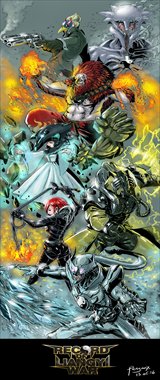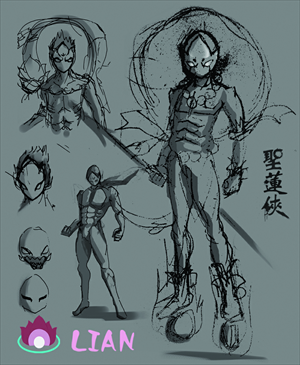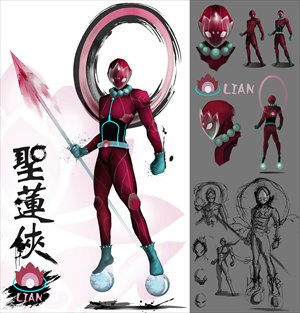HOME >> METRO BEIJING, ARTS
Homegrown hero
By Zhang Zihan Source:Global Times Published: 2013-6-24 16:08:01

Liang Rongchang's Archon characters (including Archon of Dragon) won the temox.com search for a Chinese superhero. Photo: Courtesy of Liang Rongchang
From a snowy distance, a creature looms closer, his giant size more apparent with every hulking step. His purple eyes pierce through the blizzard. A thick layer of scales covers his limbs and his tail. Whatever he is, he's not human.
He is Archon of Dragon, a ruthless creature who has the power to harness the cold, a strength he draws from a special stone in his chest. Though his tough appearance makes him look like a page out of Hellboy, X-Men or Thor comic books, his power - called liang yi, the alternate name of tai chi - indicates his Chinese blood.
Archon of Dragon hasn't yet defeated any evil villains. So far, he's only conquered the Chinese Superhero Design Contest, a competition held by comics fan site temox.com to encourage a new generation of homegrown crusaders. The winning entry came from the mind of Liang Rongchang, a 27-year-old graphic designer.
China seems hungry for superhero productions: Ironman 3 reeled in 7 billion yuan ($1.14 billion) in Chinese box offices this summer and Superman: Man of Steel just scooped up 36 million yuan last Thursday, its first day in Chinese theaters.
Chinese characters in these films rarely act as more than walk-ons or tokens to attract Chinese audiences rather than meaningful superheroes. The fan community of temox.com wants to see this change.
"Superheroes symbolize the zeitgeist of an age. And right now our society needs superheroes as it's under the threat of corruption, pollution, war and food security issues. I wish I could see a Chinese superhero fight against these threats," said Zhang Zhixuan, 28, the third-prize winner of the contest for his Holy Lotus character.

Zhang Zhixuan won third place in the temox.com Chinese Superhero Design Contest for Holy Lotus, who wields a spear and has psychic powers.

Zhang developed the character from sketches and ink paintings, then enhanced the design with computer graphics. Photos: Courtesy of Zhang Zhixuan
Here they come to save the day
Liang's creation bested 62 other entries to win a place on temox.com. The icy creature Archon of Dragon is only the beginning of Liang's vision. He created four Archons - Zhuque (phoenix), Baihu (tiger), Xuanwu (turtle) and Canglong (dragon) - to correlate with the gods of the four directions in Chinese mythology.
"[They] are well-known to most Chinese and the source of my creativity," Liang told Metropolitan.
Third-place winner Zhang, a 28-year-old college art teacher, created Lian, or Holy Lotus, an 18-year-old college student who gains his superhuman abilities in an accident. With the agility of Spiderman combined with the psychic power to move objects like Jean Grey from X-Men, the pink-suited superhero was inspired by the legend of Nezha, a Taoist protection deity, originally from Chinese Buddhist mythology.
Unlike Liang's superheroes who live in a fictional universe, Zhang said his character lives on earth. "He would have to tackle those real problems in our society, as well as those in his double life," said Zhang.
Drawing from influences
Contest judge Tekmen Lam, 28, has made superheroes his life. He designs the look of superhero characters, from their suits to their weapons.
While he commended the entries, Lam acknowledged that many submissions had Chinese elements like dragons or Peking Opera masks, but the overall designs were heavily influenced by Japanese manga or American comics.
For example, though Zhang's Holy Lotus was painted in an ink brush style, it wasn't of Chinese origins. "I was inspired by a Japanese computer game which features ink painted characters," Zhang said.
"This marks the current situation: China does not have any iconic superhero whose style and design can be generally accepted as representative," said Lam, also the designer of Armor Hero, a superhero TV series that could be regarded as the Chinese answer to the Power Rangers.
Lam said most works were inspired by Chinese legends or traditional literature. Though this makes these works more Chinese, at the same time, he said, this also makes them less original.
"They were either inspired by traditional classics like Journey to the West, or the five basic elements of Chinese culture (fire, water, wood, earth and metal). This may bore readers," said Lam.
By fans, for fans
Most superhero fans grew up watching or reading superhero sagas. To them, the word means something more than fictional character.
Zhang said he first encountered Superman stories in kindergarten and has watched Justice League and The Avengers ever since. Though there are many more rich and powerful superheroes, Spiderman has always resonated most deeply with him.
"Before he got his superpowers, Spiderman was only an ordinary person. He's not as rich as Bruce Wayne or Tony Stark, and he's not as powerful as Clark Kent, which makes his superpower more precious," Zhang said. "Apart from superhero life, he lives like a normal young guy, which makes his stories more real to me. To be honest, he makes me feel like I can save the world one day as well."
Zhang said he sincerely whishes China can one day have its own influential superhero.
Liang agrees, saying, "I believe it's essential for a country to have its own superheroes. They are symbols of what a country values."
Failure to take off
Why, then, hasn't a Chinese superhero taken off?
Based on his experience in the industry, Lam said most superhero productions in China today are based on merchandizing potential.
"Justice League and The Avengers have been developing for decades in the US. Through time, their companies balanced the art and business values of these works to ensure they're both high quality and can generate consistent profits," said Lam.
"[Chinese] producers were eager to copy the success of the Transformers franchise with similar robot productions," Lam said. "Copying is their main task. The artistic value of superheroes is regarded as less important."
Fiction writer and satirist Ma Boyong thinks the creation of Chinese superheroes also faces challenges due to censorship.
"Superheroes have to fight against monsters or terrorists. Americans and Japanese often smash their metropolises, but can you imagine a battle in Beijing? Fighting at Tiananmen Square is a blaspheme, while damaging the Great Wall would be obliterating China's international image. The terrorists? Where do they come from? This will lead to diplomatic conflict! Why make trouble for our country?" Ma wrote on his blog.
Liang, for one, plans to continue developing his liang yi-powered Archon characters, evil villains and potential story lines. Whether or not his work will catch the eye of movie producers and comic book publishers is hard to say. He's not Superman, after all.
Posted in: Metro Beijing, Comics